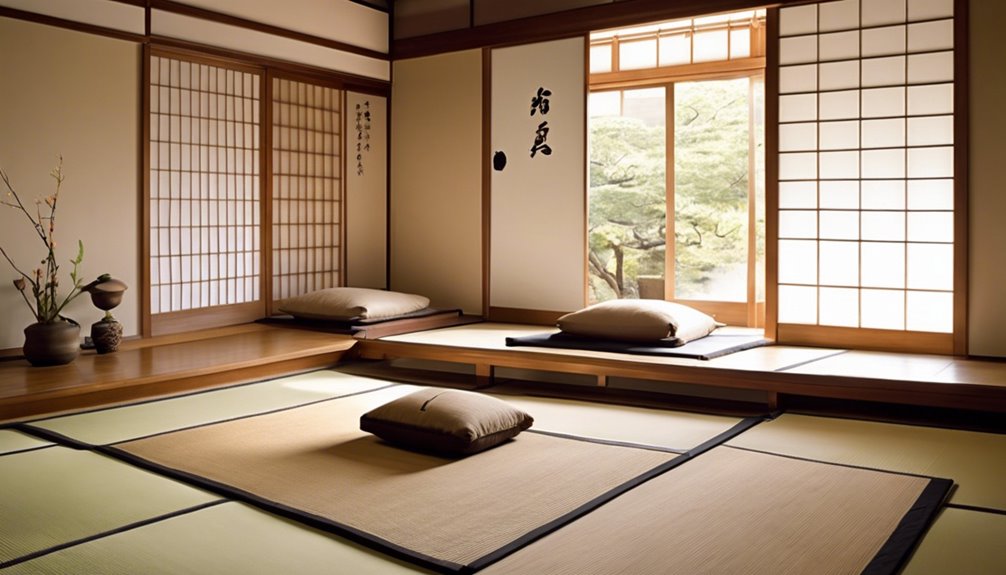Japanese people sleep on the floor for a mix of cultural, health, and practical reasons. Historically, this practice connects to a minimalist lifestyle that values harmony with nature. You'll notice futons rolled out on tatami mats, offering firm support that can enhance spine alignment and boost overall sleep quality. This way of sleeping also optimizes limited space, allowing rooms to serve multiple purposes. As you observe modern adaptations, the tradition evolves while still holding a deep cultural significance. You might be intrigued to explore how these sleeping arrangements influence daily life and well-being in contemporary Japan.
Historical Context of Floor Sleeping
While many cultures prioritize elevated beds for sleep, Japan's historical context of floor sleeping reveals a unique relationship with space and comfort. This practice, rooted in ancient traditions, is not merely about physical rest but also reflects deep cultural values. For centuries, the samurai embraced floor sleeping, as it promoted a sense of discipline and connection to the earth. These ancient practices shaped living spaces, encouraging minimalism and flexibility. You'll find tatami mats providing warmth while allowing for easy reconfiguration of space, fostering a sense of freedom. In this way, floor sleeping becomes a canvas for personal expression, intertwining comfort with cultural identity, inviting you to experience a lifestyle that harmonizes with nature and prioritizes simplicity.
Cultural Significance of Futons
When you consider the cultural significance of futons in Japan, it's fascinating to see how historical sleeping practices have shaped modern lifestyles. These versatile bedding options not only honor tradition but also serve as space-saving solutions in often compact living environments. It's a reflection of a culture that values simplicity and functionality, making futons much more than just a place to sleep.
Historical Sleeping Practices
As you step into a traditional Japanese home, you're likely to notice the subtle elegance of futons laid out on tatami mats, a sleeping practice steeped in history and cultural significance. These sleeping customs have evolved over centuries, reflecting Japan's unique relationship with space and nature. Originally, futons were simple, practical layers of cotton and wool, easily rolled up and stored away, allowing for versatile living spaces. This adaptability speaks to a cultural evolution that values minimalism and harmony. You might find it fascinating how this practice promotes a connection to the earth, grounding individuals in their environment. Ultimately, sleeping on the floor isn't just about comfort; it embodies a way of life that cherishes simplicity and intentionality.
Space-Saving Solutions
In a world where space is often at a premium, the cultural significance of futons in Japan becomes strikingly apparent. You might notice how these versatile bedding options embody minimalist living, allowing for fluidity in urban design. By simply rolling up a futon, you instantly transform your living area, creating a sense of openness that larger furniture doesn't permit. This adaptability reflects a lifestyle that values both functionality and freedom—freedom from clutter and the constraints of traditional furnishings. As urban spaces grow smaller, the futon stands as a representation of innovative design solutions, merging comfort with practicality. It's not just a sleeping arrangement; it's a cultural touchstone that champions simplicity while enhancing the quality of life in bustling environments.
Space-Saving Benefits
When you think about living in Japan, the use of futons on the floor reveals a clever approach to maximizing limited space. By simply rolling up your bedding during the day, you create an open area that feels much larger and more versatile. This easy storage solution not only enhances the practicality of small rooms but also reflects a lifestyle that embraces minimalism and functionality.
Maximizing Living Space
One of the most striking aspects of sleeping on the floor in Japan is how it exemplifies the art of maximizing living space. You'll notice that floor arrangements are often designed with flexibility in mind, allowing rooms to serve multiple purposes. This adaptability aligns perfectly with a minimalist lifestyle, where less is truly more. By choosing futons over bulky beds, you can easily roll them up during the day, freeing your space for activities or gatherings. This practice not only creates a sense of openness but also fosters a deeper connection to one's environment. Embracing such simplicity invites freedom, encouraging you to focus on experiences rather than possessions. Ultimately, it's about finding harmony in your living space and enjoying a life unhindered by clutter.
Easy Storage Solutions
While you might assume that sleeping on the floor limits storage options, the opposite is often true in Japanese homes. This approach to minimalist living encourages clever use of space, making room for innovative storage solutions. Instead of bulky beds, you'll find multifunctional furniture that adapts to your needs.
Consider these effective storage ideas:
- Futons that can be easily rolled away
- Tatami mats with hidden compartments
- Sturdy storage boxes that double as seating
- Wall-mounted shelves to keep floors clear
- Foldable tables that can be tucked away
Health Advantages of Floor Sleeping
Though it might seem unconventional to some, sleeping on the floor in Japan offers several health advantages that can enhance overall well-being. For those seeking better posture support, the firmness of a tatami mat encourages a natural alignment of the spine. It's believed that this can alleviate back pain and improve muscle health over time. Additionally, being closer to the ground may help with circulation, as your body can distribute weight evenly without sinking into a soft mattress. Many people also find that floor sleeping promotes a more restful sleep, as it fosters a cooler environment and minimizes allergens. Embracing this practice could lead to significant health benefits, making it an appealing choice for those craving freedom in their sleeping habits.
Seasonal Adaptations and Comfort
As the seasons change, so do the methods and materials used for sleeping on the floor in Japan, reflecting a deep-rooted cultural adaptability. You'll notice that seasonal comfort plays an essential role in how people choose their bedding. In winter, thicker futons provide warmth, while lighter ones are preferred in summer. This climate adaptation highlights an understanding of nature's rhythms.
- Straw tatami mats for insulation
- Futons layered for extra warmth
- Cooling sheets made of breathable fabric
- Heated floors (ondol) for chilly nights
- Lightweight blankets for easy storage
These choices not only guarantee comfort but also create a fluid living environment that harmonizes with the changing seasons, allowing for a truly liberated way of resting.
Influence of Traditional Japanese Homes
The design of traditional Japanese homes greatly shapes the practice of sleeping on the floor, offering both practicality and aesthetic appeal. With tatami mats as the foundation, these spaces embody a minimalist design that promotes simplicity and balance. You'll notice how these mats create a warm, comfortable surface for sleeping while also enhancing the room's tranquility. This connection to nature and open space invites a sense of calm, allowing you to unwind. The layout of these homes often emphasizes flexibility, enabling you to easily rearrange the living area for different purposes. Ultimately, the tradition of sleeping on the floor reflects a lifestyle that values minimalism, comfort, and harmony with one's surroundings, making it an integral part of Japanese culture.
Modern Perspectives on Sleep Habits
Sleeping on the floor may seem like an antiquated practice, yet modern perspectives on sleep habits are evolving. In urban living, where space is limited, more people are reconsidering their sleep environments. The minimalist lifestyle promotes not just decluttering, but also better sleep hygiene.
You might find these insights interesting:
- Sleeping on the floor can improve posture and spine alignment.
- Futons are easy to store, maximizing your living space.
- It encourages a deeper connection to tradition and culture.
- Floor sleeping can maintain cooler temperatures, ideal for hot summers.
- Many report better sleep quality due to reduced allergens.
As you explore these perspectives, you might discover that simplicity can lead to a more restful night.
Frequently Asked Questions
Do Japanese People Prefer Futons Over Western-Style Mattresses?
You might notice many Japanese people prefer futons over Western-style mattresses. One reason is the futon's benefits, like easy storage and better air circulation, which can enhance sleep quality. Additionally, futons hold cultural significance, reflecting traditional values of simplicity and minimalism. This approach to sleeping can create a sense of freedom, allowing for a more adaptable living space. So, when you observe this preference, it's rooted in both practicality and deep cultural heritage.
How Often Do Japanese People Change Their Futons?
You might be curious about how often Japanese people change their futons. Typically, futon maintenance frequency varies, but many folks air them out daily and wash the covers weekly. This practice stems from traditional bedding practices that prioritize cleanliness and comfort. By doing so, they keep their sleeping environment fresh, which is essential for a good night's sleep. Embracing these routines can offer a sense of freedom and well-being in your own space.
What Materials Are Commonly Used in Futon Bedding?
When you explore futon materials, you'll notice a blend of natural and synthetic options. Cotton's often favored for its breathability, while polyester is popular for durability. As for bedding types, traditional futons are filled with cotton or wool, providing comfort and warmth. You might also find options with memory foam for added support. This mix of materials allows you to choose what best suits your comfort and lifestyle preferences, promoting a sense of freedom in your sleep experience.
Is Floor Sleeping Common Among Younger Generations in Japan?
You might notice that floor sleeping is less common among younger generations in Japan, reflecting a cultural shift. Many young people are gravitating towards Western-style beds for comfort and convenience, influenced by global trends. Yet, some still appreciate the traditional futon for its space-saving qualities and connection to their heritage. This blend of modernity and tradition creates a unique sleeping culture, where personal preference often dictates choices, allowing for a sense of freedom in living spaces.
How Do Japanese People Maintain Cleanliness When Sleeping on the Floor?
"Cleanliness is next to godliness." In Japan, maintaining cleanliness while sleeping on the floor is deeply rooted in cultural significance. You'll notice people often engage in cleaning rituals, like removing shoes before entering living spaces. Futons are aired out daily, ensuring a fresh sleeping environment. This practice not only promotes hygiene but also reflects a respect for space. By keeping their surroundings tidy, they cultivate a sense of tranquility and freedom in their homes.




